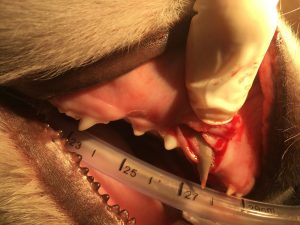Like humans, dogs go through a lifetime cycle with 2 sets of teeth. While born with no visible teeth, at approximately 3 weeks of age, their so called “puppy’ (or primary or deciduous) teeth start erupting. This process continues for approximately 3 months when a total of 28 teeth will be visible.
Puppies tend to like chewing. This action is partially a learning tool as they explore and taste their new environment. This behavior tends to increase during the infamous ‘teething’ process. At approximately 3 ½ to 4 months of age, the puppy teeth start to fall out as the underlying permanent /adult teeth erupt. Chewing helps this process and can soothe the gum tissue. During this time, puppy owners may note some blood on chew toys or an occasional tooth ‘crown’. However this top portion of the puppy tooth is often swallowed as the pet eats so may not be found. Providing adequate chew toys during this teething process can help your puppy and may discourage chewing on less desirable items (such as shoes and TV remotes). At about 5-7 months of age, most dogs will have finished teething and their new 42 adult teeth are all in position.
4 more common abnormalities that can occur include:
1) Absent teeth. Sometimes dogs do not end up developing full sets of puppy or adult teeth. This can occur for a number of reasons and is more common in certain breeds.
2) A deciduous/puppy tooth does not fall out at the designated time. This is called a retained tooth and also happens for a number of different reasons. Unfortunately, this can lead to poor positioning/alignment of the adult teeth needing to come in and creates areas where food and hair entrapment occurs. Most commonly, this involves the upper canine teeth.
3) Tooth fractures can happen to both puppy and adult teeth. Because this potentially exposes the tooth’s pulp cavity where the blood and nerve supply reside, as well as providing an opening for bacteria, this is a concern.
4) A gray discolored tooth which typically signifies a dead or nonviable tooth.
In just the past week, I have seen abnormalities 2-4 (see photos of 3 and 4 below). In discussion with our local veterinary dentists at Companion Animal Dentistry, removal/extraction of the affected teeth was recommended due to the potential for damage and/or infection spreading to the underlying adult tooth and it’s bud where development takes place.


In summary, puppy teeth are sharp, important, and require attention just like their adult counterparts. Remember to start teeth brushing early on your puppies and monitor for any unusual sights. With each puppy visit and adult visit, teeth are one of the body parts we routinely examine to help you maintain ideal oral health and and function. If you have any question or concerns, we are here for you and your pets.

Recent Comments